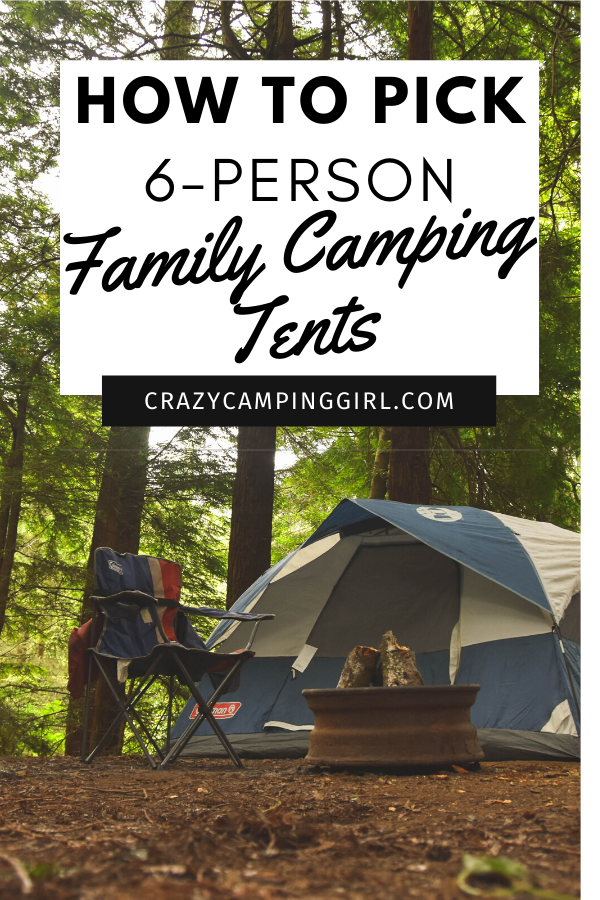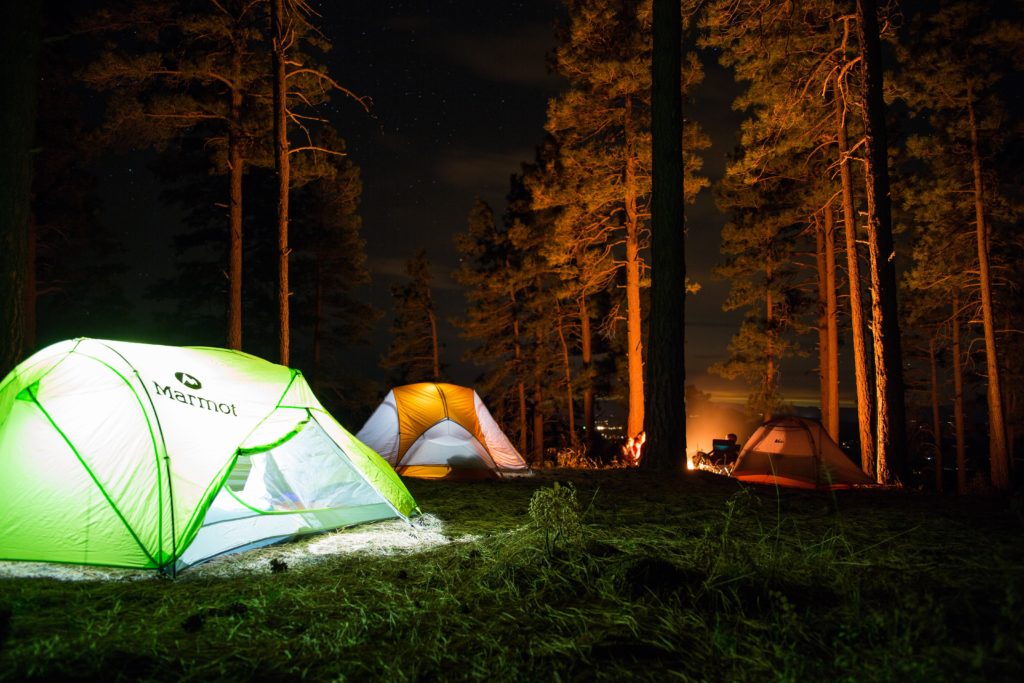
How to Pick 6-Person Family Camping Tents
We may earn money or products from the companies mentioned in this post.
When purchasing family camping tents (6-person or more massive), everyone will have different requirements. With so many options in size, weight, quality, and style, what should be considered before a final decision is made?

As with any purchase, there are often compromises to be made, and this guide aims to make those choices a little clearer.
What should be considered when comparing 6-person family tents or more substantial, for camping?
Finding the right kind of tent for the next backpacking or camping trip is crucial. A tent is an essential piece of backpacking gear, as it can provide a stable shelter during inclement weather. There are several kinds of tents and many designs, so finding the right one can be a crucial decision.
What Makes a Tent?
A tent is comprised of several items that all the users to set it up properly.
- The tent body: Usually made of nylon, the tent body includes the floor, sides, roof, and windows all sewn into one component.
- The rain fly: A separate piece of nylon that fits snugly over the tent body to protect it from the rain and elements.
- Tent poles: Made of carbon fiber, these are used to keep the tent erect and give it shape.
- Stuff sack: For packing the tent up and protecting it when not in use.
- Nylon cord: Often provided by the manufacturer for making guy lines, which provide extra support to the tent in windy conditions
How Big Are Tents?
Tents can be classified into several categories. They include:
- One-person tents: These are designed to accommodate only one person, and can be very lightweight for those hiking by themselves.
- Two-person tents: Can accommodate two persons comfortably.
- Three-person tents: These tents are larger and heavier. They are meant for large group expeditions.
- Four-person+ tents: Large and very heavy, these tents are more appropriate for car-camping or family camping. These make great family camping tents.
Remember, the larger the size of the tent, the more it will weigh.
What Seasons Are Appropriate for Tents?
A tent is rated for a particular season or group of seasons. These are the times when the shelter provides enough adequate protection from the elements and temperature.
Many tents are three-season tents, which means that they can be used in Spring, Summer, and Fall. A four-season tent can be used all-year-round, including winter.
What Kinds of Features Do Tents Have?
That depends on the manufacturer and brands. Some standard features that tents may have include:
- A vestibule: This is part of the rain-fly that reaches out beyond the tent to create a dry, covered spot just in front of the door. This is a spot to place a pack of hiking boots.
- Tent mesh pockets: These are sewn inside the tent along the wall and allow the user to stash small items such as a notebook, flashlight, etc.
- A footprint: A footprint is a ground cloth that is cut to fit the exterior bottom of the tent. It protects the tent from punctures from rocks, sticks, pine needles, and water.
- A ring or hook inside the tent for hanging a flashlight or headlamp.
- Two doors, one for each tent-mate, with one on each side.
Knowing All the Factors For A Tent
By knowing all the different technical factors in a tent, including size, appropriate season, and features, one make an informed choice when buying a tent.
Family Camping Tent Price and Quality
The price of family tents (6-man tents and above) can vary widely, and the old adage, “You get what you pay for” usually applies.
Higher-priced tents will typically be of superior quality in terms of manufacturing and material. On occasion, the difference might be more subtle, such as a light tent or an easier method of pitching.
The ‘quality’ of a tent is often judged on the stitching, materials, and attention to detail. Mesh and modesty panels on doors, sewn-in fly-sheets, and double zippers will all be present at the higher end of the family tent market. Top specification tents will also have been designed to improve ventilation, include safe ways to allow electricity supplies in and keep the living areas cool.
Tents are given a ‘season’ rating, dependant on what sort of weather conditions they have been designed to withstand. A 1-season rating is the lowest and implies a summer tent, best suited to mainly dry weather with little wind, a 4-seasons rating (the highest) suggests the tent can be used in potentially snowy, high wind environments – often suited to mountaineering or similar pursuits. The 2- or 3-season ratings fall between the two.
Camping Equipment Waterproof Rating – Hydrostatic Head Measurement
Hydrostatic head rating is a method for comparing how ‘waterproof’ one tent is, with another. The score denotes the amount of pressure required before water penetrates the fabric. The higher the rating, the more waterproof a tent should be.
The British Ministry of Defence deems anything with a grade of 800 mm or higher as waterproof. For family camping, a score of 1,500 mm to 2,000 mm is a more desirable minimum.
The weight of family camping tents is one area where a certain level of compromise might be required. Much of the weight of a tent comes from the poles used to erect it.
Steel poles are much heavier than fiber poles, and also more expensive, but they are stronger, and typically easier to use. If weight and price are not a primary consideration, steel poles should be favored. Higher quality tents will tend to use more steel poles.
Other Considerations for 6-Person Family Tents and Up
Manufacturer sleeping berth figures are primarily very optimistic, particularly where families are concerned. The room will be needed for all sorts of kit (all the stuff you pack to bring with you), in addition to any sleeping areas. The size of a tent will have a direct correlation to weight, so those wishing to travel light may need to sacrifice space.
The shape or style of a family tent will often dictate the amount of space, and certainly the amount of headroom or the useable ‘standing’ area. Tunnel tents provide the most room in terms of being able to stand upright, but dome tents with additional room compartments may offer a greater floor area.

Over time, a family will need their tent to change along with their own needs. Children may grow too big to share a room, for example.
Some tents lend themselves very well to these changes and offer ‘dividers’ in places that can split one room into two smaller ones. This additional flexibility could prove very valuable when looking at camping for the family long term.
Keeping the stress of tent pitching to a minimum can be invaluable. Tents are often sold with a pitch time estimate or a score of how easy they are to put up. The ease of pitching will be more important to those families with younger children who can not lend a hand or need supervision.
If possible, check the pitching instructions and note the number of people required to pitch the tent – two adults may not be enough for some of the more complicated pitch methods.
Tents often include some level of storage, either by way of hanging dividers or sewn-in pockets. These can prove very handy for keeping essential equipment off the floor.
Color is also more than just an aesthetic choice, as darker tents will tend to get hotter during the day. More adventurous families may want a brightly colored tent in case of an emergency where they need to be spotted from the air.

A substantial porch is also something that can easily be overlooked. In bad weather, a well-designed porch can offer a sheltered place for cooking, avoiding the obvious danger of cooking inside a tent, which is too dangerous.
Some tents are designed with a specific porch area, rather than the standard door held open with poles.
The plethora of different options within the family tent market illustrates the diverse and individual needs of campers generally and families specifically. Every family will need to think about their own needs and requirements before settling on a tent to purchase.
Reviews are always helpful, but more than anything, an effort should be made to view the tent pitched. The ability to walk into a family tent and judge the size, quality, and layout is priceless.
Other posts you may enjoy:
- How to Camp When the Ground is Wet
- 10 Camping Tips For When It Is Hot
- 11 Tips for Camping with Toddlers
- How to Camp With Dogs
- How do You Keep Your Food Cold When Camping Without a Fridge?
